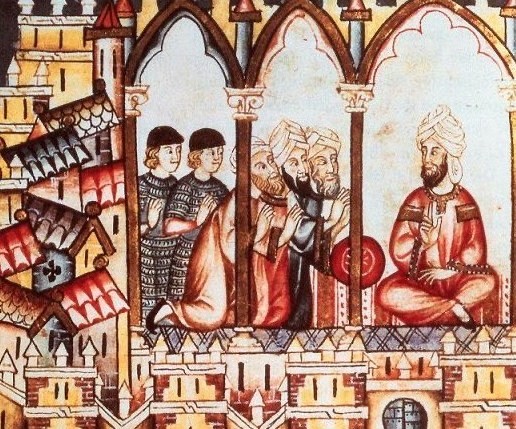

The Moors Introduced Numerous New Fruits and Vegetables to Europe
The Moors introduced a variety of fruits and vegetables that were previously unknown in both Spain and Europe and thus deemed exotic novelties. These items included peaches, lemons, oranges, saffron, cotton, rice, silk, sugar cane, apricots, figs, dates, pomegranates and many others. Although commonplace today, during the Middle Ages these items were almost alien to the Spanish. Centuries later, they have become staples of Spanish production and diet.
2. Architecture
The Moors Were Several Steps Ahead of Medieval Europe. At the time of their conquest of the Iberian Peninsula, the advanced civilization of the Arabs was renowned for its architecture, science, mathematics and exploration. Upon their arrival in Spain, the Moors introduced architectural techniques that amazed European stonemasons. One of the most impressive examples of Moorish architecture is the Alhambra, a palace complex and fortress located in Granada, Spain. Construction began in 1238, and it surpassed any similar palace in grandeur and beauty. Today, it remains one of the best-preserved palaces of the Islamic world.
3. Chess Spread Throughout Europe Thanks to the Moors
Even though chess is over 1,500 years old, it was first introduced to Europe in its current form by the Moors. Chess spread from India to the Arabic world and was introduced to Spain by the Moors. It quickly became popular and swept across Europe's courts and society. In medieval Spain, chess was a popular game of strategy and patience. The first written mention of chess in Spain dates back to 1010 AD, in the Catalonian Testament.

4. The Moors Were Very Strict About Their Hygiene
The Moors were known for their love of cleanliness, with a popular saying claiming that a Moor "would rather go without bread than without soap.” Due to their traditions and the rigours of their religion, the Moors were fond of looking spic and span, and encouraged frequent bathing; In the Moorish town of Cordoba, there were around 900 public baths. This allowed for proper hygiene during a time when plumbing and running water were not yet widely available. Some sources also claim that the Moors brought some form of soap to Europe, introducing a new era of cleanliness.
5. Education Was Very Important to the Moors
Education was of utmost importance to the Moors, who ensured that it was universally available to all within their realm. This stood in stark contrast to medieval Europe, where 90% of the population remained illiterate, and education was reserved for only the wealthiest nobles and clergy. In fact, there were even some European Kings who could not read or write. The Moors established 17 great universities in Spain, located in cities such as Cordoba, Malaga, Granada, Seville, Toledo and Almeria, among others.
6. Language
Numerous Moorish Words Found Their Way into Modern Spanish and English
After their arrival in Europe, the Moors brought with them new concepts and words that quickly became a standard part of everyday language. Spanish has up to 4,000 words of Arabic origin, including algebra, checkmate, and influenza. Other examples are a cypher, alcohol, chemistry, typhoon, orange, alkaline, cable and nadir.
7. The Moors Were Very Industrious
Upon their arrival in Iberia, the Moors saw the potential in the old Roman irrigation systems they found and quickly adopted, enhanced and revived them. This led to a surge in agricultural productivity and a boost in the economy. They were also able to cultivate new crops they brought with them such as lemons, oranges, figs, dates, and apricots. Soon, Spain became one of the largest producers of crops in Europe, all thanks to the Moors' innovative irrigation techniques.
8. The Moors Greatly Transformed Spanish Cuisine
Spices were a rare commodity for Europeans, and their food was often considered bland. The Moors changed that by bringing over hundreds of unique spices, new recipes and innovative methods of preparing food. This culinary revolution gave rise to many wondrous dishes we still enjoy today. The Moorish spice markets were famous for their variety, offering choices for cooks of all styles. The colours and smells of these medieval markets must have been truly incredible.
The Moors introduced new musical instruments and styles to Spain, such as the lute and the flamenco dance, which have become integral parts of Spanish culture.
9. Science and Medicine
The Moors were pioneers in science and medicine, and their knowledge was passed down to the Spanish through translations of Arabic texts. This influence can be seen in the development of Spanish medicine and science during the Renaissance.
However, the Christian kings and rulers were at loggerheads with Moors for obvious reasons. The Territory. The Reconquista (Spanish, Portuguese, and Galician for "reconquest") is the historical term used to describe the centuries-long military campaigns that Christian kingdoms waged against the Moors from the 8th century until 1492, in order to retake or reconquer the Iberian territories which were lost.
Finally, on January 2, 1492, King Boabdil surrendered Granada to the Spanish forces, and in 1502 the Spanish crown ordered all Muslims forcibly converted to Christianity. The next century saw a number of persecutions, and in 1609 the last Moors still adhering to Islam were expelled from Spain. Between 1492 and 1610, some 3,000,000 Muslims voluntarily left or were expelled from Spain, resettling in North Africa.
But it has to be acknowledged that overall, the Moors made a significant impact on Spanish culture, and their influence can still be seen today in various aspects of Spanish life.
@ Yeshwant Marathe
yeshwant.marathe@gmail.com
Thanks to Prashant Naik for his inputs

